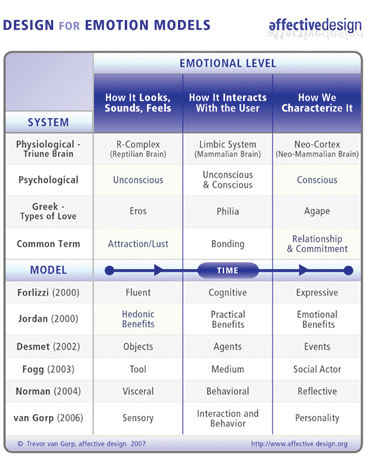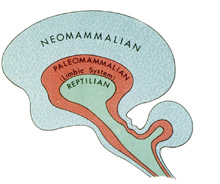With all the different models out there used to describe designing for emotion, it can be difficult to understand how to apply any individual model, or understand how all the models relate to each other. Several years ago, I set out to gain an understanding of how these models were different and how they were similar.
Although an overview of the design models reveals differences, a comparison also reveals some common themes. Each researcher uses a tripartite division where each level focuses on a particular aspect of the way that products elicit emotion. The matrix below illustrates.

(Download the Design for Emotion Models diagram (888KB PDF) with references.)
OBJECT:
Products as Objects – Appraisals of Appeal against Attitudes
Technology as Tool – Has instrumental value
Hedonic Benefits – Sensory and aesthetic pleasures
Visceral Design – Appearance and tactile qualities
AGENT OR MEDIUM FOR EXPERIENCE:
Products as Agents – Appraisals of Legitimacy against Standards
Technology as Medium – Helps to represent information and identify cause and effect relationships
Practical Benefits – Resulting from, or the outcome of, the completion of tasks
Behavioral Design – Effectiveness and ease of use
EVENTS:
Products as Events – Appraisals of Motive Compliance against Goals
Technology as Social Actor – Emotional responses to technology
Emotional Benefits – How a person’s emotions are affected by products
Reflective Design – Self-image, personal satisfaction, memories
At the level of the object, all the models focus on the inherent qualities or formal properties of the object, including its appearance and physical properties, the pleasures they provide, the appraisals (or evaluations) they elicit, what functions they are designed to perform, and the first impressions they convey.
At the level of the agent or medium, the focus is on how the product interacts and performs, the benefits that use brings, appraisals of legitimacy against standards and the ways that information is represented and connected.
At the level of the event, the focus is on what the product says about us (both to ourselves and others), what kinds of memories it creates, the emotional benefits it brings, and the appraisals of motive compliance against goals it generates. At this level, the formation of relationships and brand is a concern.
If we were to apply these levels, we can begin to understand how when a customer or user encounters a product or service, they are first affected by their sensory impressions. Does the product look appealing? Does the retail office smell clean? Does the voice of the phone rep sound attractive?
Upon interacting with the product or service, social judgments come into play. These judgments have already been affected by the sensory impressions formed when the object was encountered. We judge the object based on human social rules. Does the object respond when a button is pressed? Why is it disregarding me by ignoring me? Judgments like these are unconscious social interactions.
Together, the sensory impressions and the social interaction communicate a personality over time. In this instance we can think of personality as the expression of a particular emotional state over a longer period of time.
Psychologically, we can relate these models to the unconscious and conscious minds.
 Physiologically, we can relate these models to the traces of evolution left in the brain, since some scientists theorize that emotional processing occurs in all three “brains”.
Physiologically, we can relate these models to the traces of evolution left in the brain, since some scientists theorize that emotional processing occurs in all three “brains”.
The reptilian brain is reputed to control basic survival and mating instincts. The processing that occurs in the reptilian brain is nearly instantaneous and unconscious. This explains why physical attraction can be unconscious. You don’t have to think about whether something is physically beautiful, it just is!
In the mammalian brain, unconscious and conscious processes meet. We have social instincts that govern mammalian pack behavior. The mammalian brain governs things like bonding. At this level, attraction can also manifest or grow through social interaction. Social interactions have been described as exchanges of power and status between “pack” members. Think of a pack of wolves or gorillas where there is an alpha male, alpha female and lower pack members.
When a computer frustrates you by crashing and refusing to perform your requests, your frustration is unconsciously centered around the machines refusal to acknowledge your higher power and status within the “pack”. While consciously, you have a task to perform that needs to get done.
Three of the Greek types of “love” also correspond to this model. Eros, or lust, Philia which is brotherly love, and Agape, which is unconditional love.
And finally, we could use the common terms of attraction, bonding, and commitment or relationship to describe the three levels. At the relationship level, we begin to see how all the previous exchanges between the product and the user have created the personality or brand image of the product or service.
4 replies on “Understanding Design for Emotion Models”
[…] Elements of User Experience is a great model for addressing the three emotional levels of Sensory, Interaction/Behavior and Personality. It’s natural and unconscious that the visual […]
Hi! I was surfing and found your blog post… nice! I love your blog. 🙂 Cheers! Sandra. R.
[…] https://www.affectivedesign.org/archives/199 […]
Hi, I have read Dr. Norman’s fascinating work. It was a God send to see you did all this comparative work. Thanks very much indeed from the UK ! 😉